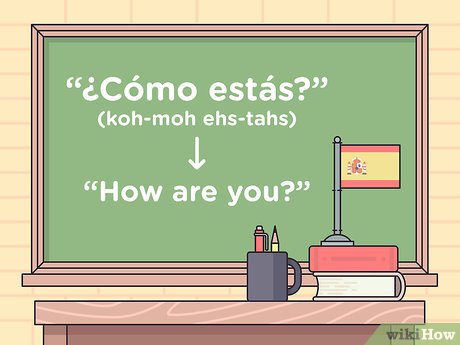How to Ask “How Are You?” in Spanish: A Guide to Greetings and Beyond
In any language, greetings are the cornerstone of social interaction. Spanish boasts a rich tapestry of greetings, particularly when inquiring about someone’s well-being. Whether you’re a seasoned Spanish speaker or just beginning your journey, mastering how to ask “How are you?” in Spanish is an essential skill.
This article delves into the various ways to ask “How are you?” in Spanish, considering formality, regional variations, and additional expressions to show genuine interest.
Formal and Informal Greetings
Spanish utilizes two verb conjugations for “to be”: “ser” (permanent state) and “estar” (temporary state). When inquiring about someone’s well-being, we typically use “estar” as it reflects a current state.
Here are the most common ways to ask “How are you?” in Spanish, categorized by formality:
-
Formal:
- ¿Cómo está usted? (koh-MOH es-TAH oo-sted) – This is the most formal way to ask “How are you?” Use it when addressing someone significantly older, someone of higher authority, or someone you don’t know well.
- ¿Cómo está? (koh-MOH es-TAH) – A slightly less formal alternative to “¿Cómo está usted?”. Still appropriate for formal settings.
-
Informal:
- ¿Cómo estás? (koh-MOH es-TAHS) – This is the most common informal way to ask “How are you?” Use it with friends, family, and anyone you consider close.
- ¿Qué tal? (keh TAHL) – A versatile and casual greeting that translates to “How’s it going?” or “What’s up?”
Regional Variations
Spanish is spoken across a vast geographical area, encompassing numerous countries and dialects. Here are a few regional variations for “How are you?”:
-
Mexico:
- ¿Cómo estás? (informal)
- ¿Cómo sigues? (koh-MOH SEE-gehs) – (informal) How are you doing?
- ¿Qué onda? (keh OHN-dah) – (very informal) Literally translates to “What’s the wave?”
-
Spain:
- ¿Qué tal? (informal)
- ¿Cómo va todo? (koh-MOH bah TOH-doh) – (informal) How’s everything going?
-
Argentina:
- ¿Cómo andás? (koh-MOH ahn-DAHS) – (informal) How are you going?
While these variations provide a glimpse into regional dialects, understanding the core greetings mentioned earlier will equip you for most situations.
Beyond the Basic Greeting
Asking “How are you?” is just the beginning. Spanish offers numerous ways to express genuine interest in someone’s well-being:
- ¿Cómo te va? (koh-MOH teh BAH) – (informal) How are things going for you?
- ¿Cómo has estado? (koh-MOH ahs es-TAH-doh) – (informal) How have you been?
- ¿Qué hay de nuevo? (keh ay deh NWAY-voh) – (informal) What’s new?
Responding to Greetings:
Here are some common responses to greetings in Spanish:
- Muy bien, gracias. ¿Y tú? (mooy byEN, GRAH-see-ahs. ¿ee TOO?) – Very well, thank you. And you?
- Bien, gracias. ¿Qué tal? (byEN, GRAH-see-ahs. ¿keh TAHL?) – Good, thank you. How are you?
- Todo bien, gracias por preguntar. (TOH-doh byEN, GRAH-see-ahs por preh-goon-TAHR) – All good, thank you for asking.
Adding Warmth:
Spanish allows you to personalize greetings with warmth. Here are some examples:
- ¿Cómo estás, {name}? (koh-MOH es-TAHS, {name}) – How are you, {name}?
- Me alegro de verte, {name}. (meh ah-leh-GROH deh ver-teh, {name}) – I’m glad to see you, {name}.
Using Context
Understanding the context is crucial when choosing how to greet someone. Consider the formality of the situation, your relationship with the person, and the time of day.
For instance, “Buenos días” (good morning).
Commenting on the Environment:
- ¿Qué lindo día, no? (keh LIN-doh DEE-ah, noh) – What a beautiful day, isn’t it?
- Hace mucho calor, ¿verdad? (ah-seh MOO-choh kah-LOR, ¿ver-DAHD?) – It’s very hot, right?
Expressing Interest in the Person:
- ¿Cómo está tu familia? (koh-MOH es-TAH too fah-MEE-lyah) – How is your family? (familiar)
- ¿Estás trabajando en algún proyecto interesante en estos días? (es-TAHS trah-bah-HAHN-doh en ahl-GOON proh-YEK-toh een-teh-reh-SAHN-doos DEE-ahs) – Are you working on any interesting projects these days? (polite)
Remember, a genuine smile and friendly tone go a long way in Spanish conversation, just as they do in any language.
FAQ: Frequently Asked Questions about Greetings in Spanish
Q: When to use “usted” vs. “tú”?
A: Use “usted” in formal situations, with someone significantly older than you, or with someone you don’t know well. Use “tú” with friends, family, and anyone you consider close.
Q: Are there any other ways to greet someone in Spanish?
A: Yes! There are greetings specific to the time of day, such as “Buenos días” (good morning) or “Buenas tardes” (good afternoon).
Q: How can I improve my greetings in Spanish?
A: Practice! Listen to native Spanish speakers and try to mimic their greetings and conversational style. There are also many online resources and apps available to help you learn Spanish greetings.
By understanding the nuances of greetings in Spanish, you can navigate social interactions with confidence and build meaningful connections with others.



